How Well Does the QNAP TS-233 NAS Perform as a Plex Media Server?
Deciding on buying a NAS for use as your own private Plex Media Server is NOT an easy choice for many users. Although the building blocks of NAS servers are comparable to domestic PCs and Laptops, NAS systems are alot of focused/specific in their utility and for many, the price tag that many of these systems arrive with (despite having CPU+Memory combos that seem rather low-end) can be quite a barrier. Alot o NAS brands are aware of this and alongside more power/expensive systems, also have an area of their portfolio that includes a great many more affordable/value solutions for smaller scale buyers. QNAP is no exception to this and every couple of years will release a new generation affordable/value-series NAS solution that is designed to provide NAS to those of a more limited budget or task requirements. That is where the QNAP TS-233 comes in, a new ARM-powered NAS released in 2022 that promises to run the bulk of home user NAS applications without hurting your wallet too much. However, the modest specifications of these more affordable NAS drives tend to restrict Plex Media server use and many are concerned that the TS-233 NAS might not have the horsepower to get the job done. So, today I want to test the QNAP TS-233 NAS as a plex media server with 1080 and 4K media. But before we start, what is Plex? And How has it become so popular? The appeal of accessing all the movies, boxsets, music and home movies that you physically/digitally own in the style popularized by Netflix, Disney+ and Prime Video (flashy GUI, summary, all the box art, trailers, cast details, reviews and more) is undeniable. The rise in popularity of streaming platforms like Netflix has also been accompanied by rising monthly subscription costs and rising concerns about never truly owning the media that you want o watch. Even when you buy movies and TV boxsets in digital download forms from Amazon Video etc, you are still at the mercy of 1) needing somewhere to store it if you do choose to download it and 2) potentially losing access to it if the site/platform you purchased from has lost the license to host it (a common complain of the increasingly digital world of PC/Console gaming, as games are pulled from eStores). Hosting your media in a subscription-free form, whilst it still being presented in the universally accessible and premium GUI form of Plex is one of the most compelling reasons for many home/prosumer users deciding to make the jump towards buying their own plex media server. However, NAS drives have grown incredibly diverse in terms of hardware design and therefore one NAS might not play media in plex as well/efficiently as another – and the QNAP TS-233 NAS is no exception to this. Today I want to detail my tests of the TS-233 as a Plex Media Server and I hope this will help you decide whether a QNAP NAS deserves your Multimedia in 2022/2023.
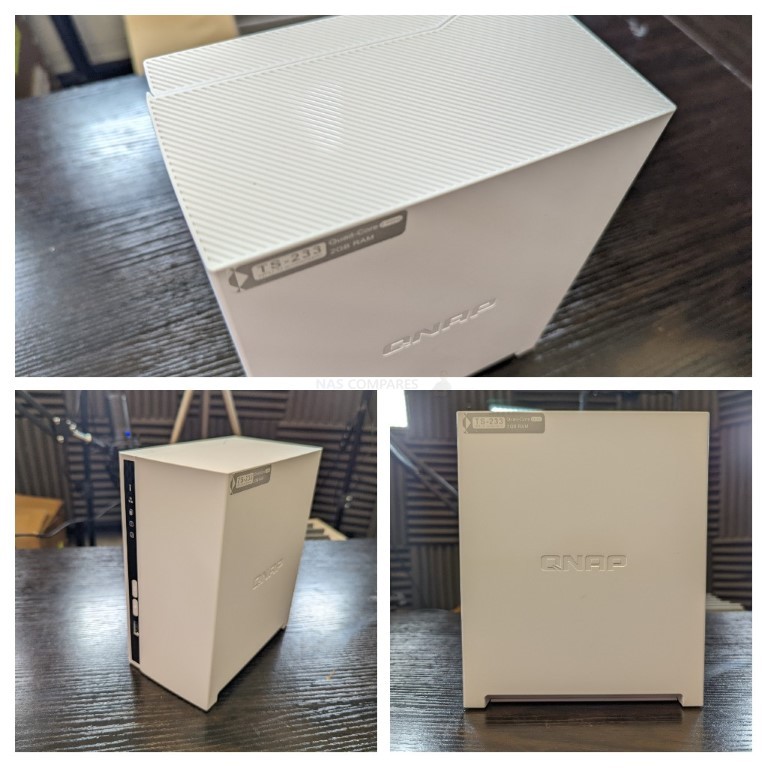
What is the Hardware of the QNAP TS-233 NAS Drive?
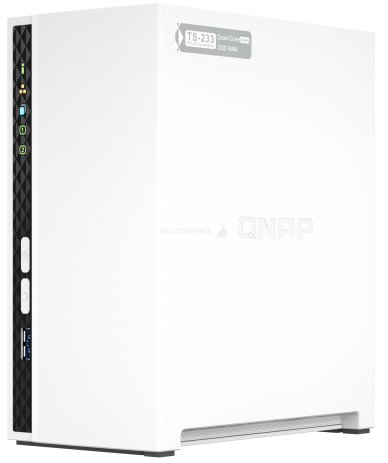
The QNAP TS-233 NAS drive is quite similar in architecture to most PCs or Laptops (in that it features a CPU+Memory+Storage), but differs in that it’s components are designed to be more efficient (as they will be in operation 24×7) and have a larger degree of focus on storage-related applications (where as the hardware in a PC/Laptop is designed more for the applications you run with storage service concerns/provisions being far more rudimentary). The TS-233 is made up of a popular mid-range server CPU, DDR4 memory and supports Hard Drive and SSDs in SATA. although most of the specifications of QNAP NAS drives are unrelated to Plex, below I have picked up the hardware specifications of the TS-233 that are relevant to Plex:
- CPU: Realtek ARM 64bit, Quad Core 1.4Ghz
- Embedded Graphics: No
- Memory (Quantity & Maximum): 2GB (Cannot be upgraded)
- Number of Storage Bays: 2x SATA Bays
- M.2 NVMe Caching Bays: No
- Network Connectivity: 1x 1GbE
Next, let’s quickly touch on how we measure how good/bad the QNAP TS-233 NAS is for Plex Media Server.
Understanding the Plex Media Server Tests of the QNAP TS-233 NAS
![]()
Important Terms to Understand in Plex/NAS/Multimedia that will make the TS-233 NAS Plex Tests Easier to Understand.
- SD, 160p, 240p, 480p, 720p, 1080p, 4K : This is the resolution that the media is being displayed at. The higher the resolution, the larger number of pixels that are available and depending on the original recording quality of the media in question. High resolutions, such as 1080p and 4K require more work to be done by the NAS hardware in order to playback the file. More often than not, a NAS with weak embedded graphics or no embedded graphics at all will be unable to play 4K very well or indeed at all. It is important to remember that just because a NAS brand like QNAP says that their latest NAS can natively play back 1080p or 4K media (natively = played using their own NAS software, software client tools and/or DLNA), that does not mean that the TS-233 will play to the same standard in Plex, as Plex is a 3rd party tool
- Transcoding, Encoding, Decoding : These are all different techniques/names for when a file needs to be changed in order to be better suited to the connected client device connection, strength or hardware. If you are accessing all your media on the local area network (i.e only accessing your plex media at home), then transcoding will rarely be something you will use (unless your media is largely H.265/HEVC based, see earlier). However, perhaps you are accessing your plex library on the train to work or from a sun bed whilst on holiday. Perhaps you have a smaller data bandwidth/allowed MB/GB, maybe a weaker internet connection, perhaps you are using a smaller phone device and you might not need to watch your 4K 50GB Blu-ray rip of the latest Marvel Movie – in these situations, you might well want to access the media on your QNAP TS-233 Plex NAS at a lesser quality than the original version, so transcoding/re-encoding on the fly (as in, at the same time it is being played) is what you would want to do. Remember, transcoding is by far the most heavy-weight thing you will need to do on a NAS. It is also worth remembering that in order for Plex o be able to use the FULL resources of a NAS CPU (such as embedded graphics) that you will need to enable ‘Make My CPU Hurt’ in the Encoder Menu of the Plex NAS Settings menu – this also potentially requires a Plex Pass subscription, depending on the NAS in question
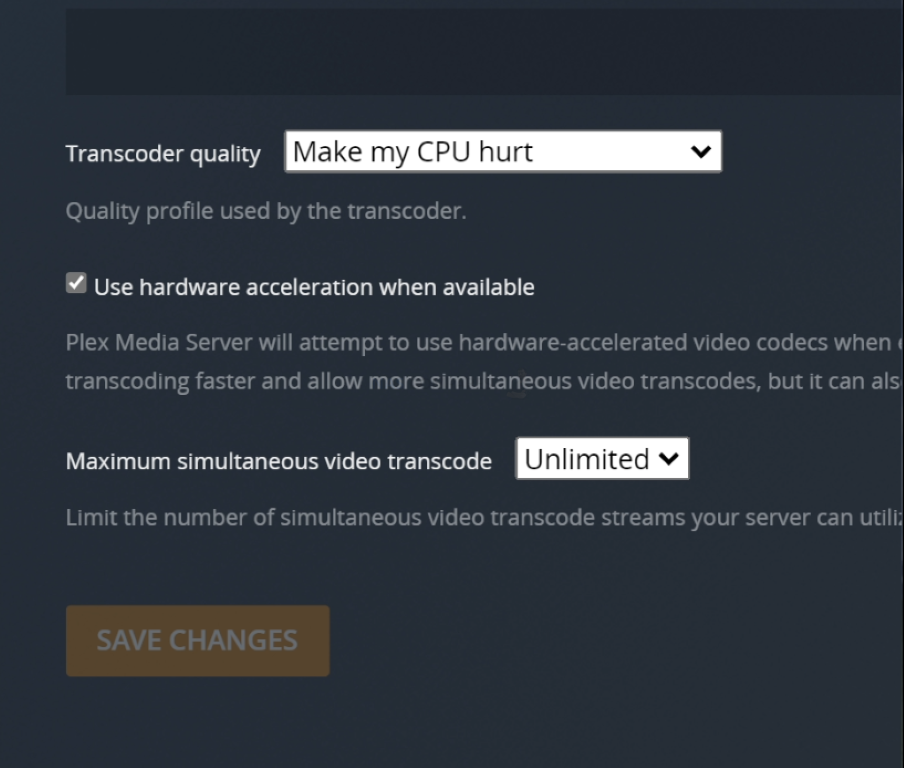
- H.264, HEVC, H.265 : These are compression techniques that are designed to allow large-scale media presentations that were made for a cinema to be viewable from your sofa (with H.265 being the more effective/powerful compression level). H.264 can largely be played by ALL devices, but many devices do not have permission or a license to play H.265/HEVC (they are the same thing). This is because, where H.264 is an easy license and comparatively free to use, H.265/HEVC licencing and patents are spread across multiple providers and allowing a device license to use this compression technique can be complex, expensive or simply impossible. Therefore HEVC/H.265 media will sometimes AUTOMATICALLY need to be converted/transcoded into H.264 etc in order to be played – therefore eating up more system resources. The TS-233, much like the rest of thte QNAP NAS range do not arrive with HEVC support by default
- Bitrate : Bitrate is the amount of data encoded for a unit of time, and for streaming is usually referenced in megabits per second (Mbps) for video, and in kilobits per second (kbps) for audio. Higher quality and higher resolution media tends to be of a much higher bitrate
For more information on the most important terms to understand when discussing/researching a NAS as a Plex Media Server can be found in my video below:
Any further questions, you can use the free advice section at the bottom of the page and ask me and Eddie directly.
How was the QNAP TS-233 NAS Tested in Plex?
The setup for testing the TS-233 NAS for Plex was as follows:
- The QNAP TS-233 NAS was accessed over a 1GbE network, however in order to test how the NAS would cope with transcoding/encoding, I would force the Plex Player client to transcode the file manually
- The TS-233 NAS was used in the default CPU+Memory state that the base model arrives in (no upgraded memory or upgraded caching media)
- Tests were performed one after the other with a short break between each test, so you might see the tail end of the previous test on a CPU graph, but I have pointed at the are of the % utilization that is important as per each test.

Regarding test results, CLEAR PASS means that the file successfully played and there were sufficient resources for the NAS to continue to do other things comfortably, PLAYED BUT HIGH CPU % means that the file played, but it utilized a significant amount of system resources in order to do so in a heavier use situation (i.e other NAS users connected) it might not play and FAIL AND-OR DID NOT PLAY means that the file either did not play or the time taken to play back the files was outpaced by the natural playback of the file – i.e. the file would stop-and-start constantly in order to try and catch up. If you want to watch the FULL video recording of all the Plex tests that I performed on the QNAP TS-233 NAS, you can watch the video below. Be warned, it is quite long! Alternatively, you can scroll past and see each of the test results, one-by-one, detailing which ones worked and which ones didn’t:
What % System Resources did the QNAP TS-233 NAS Use in Plex when Idle?
Running the Plex Media Server application, even when no multimedia is being played on the TS-233 is still going to require a % of system resources to be occupied, in order to ensure that PLEX can play media from the QNAP NAS as soon as it is requested remotely. Additionally, although Plex runs at its best with at least 2 Cores of CPU power and 2GB of Memory, many NAS also reserve areas of CPU/RAM for the system itself. So, therefore, knowing how much system resources are being consumed by the QNAP TS-233 NAS when Plex is idle is going to be useful to know how much system power is available when playback actually starts. Here is a screenshot of the TS-233 when Plex is running, but no media is being played/accessed:
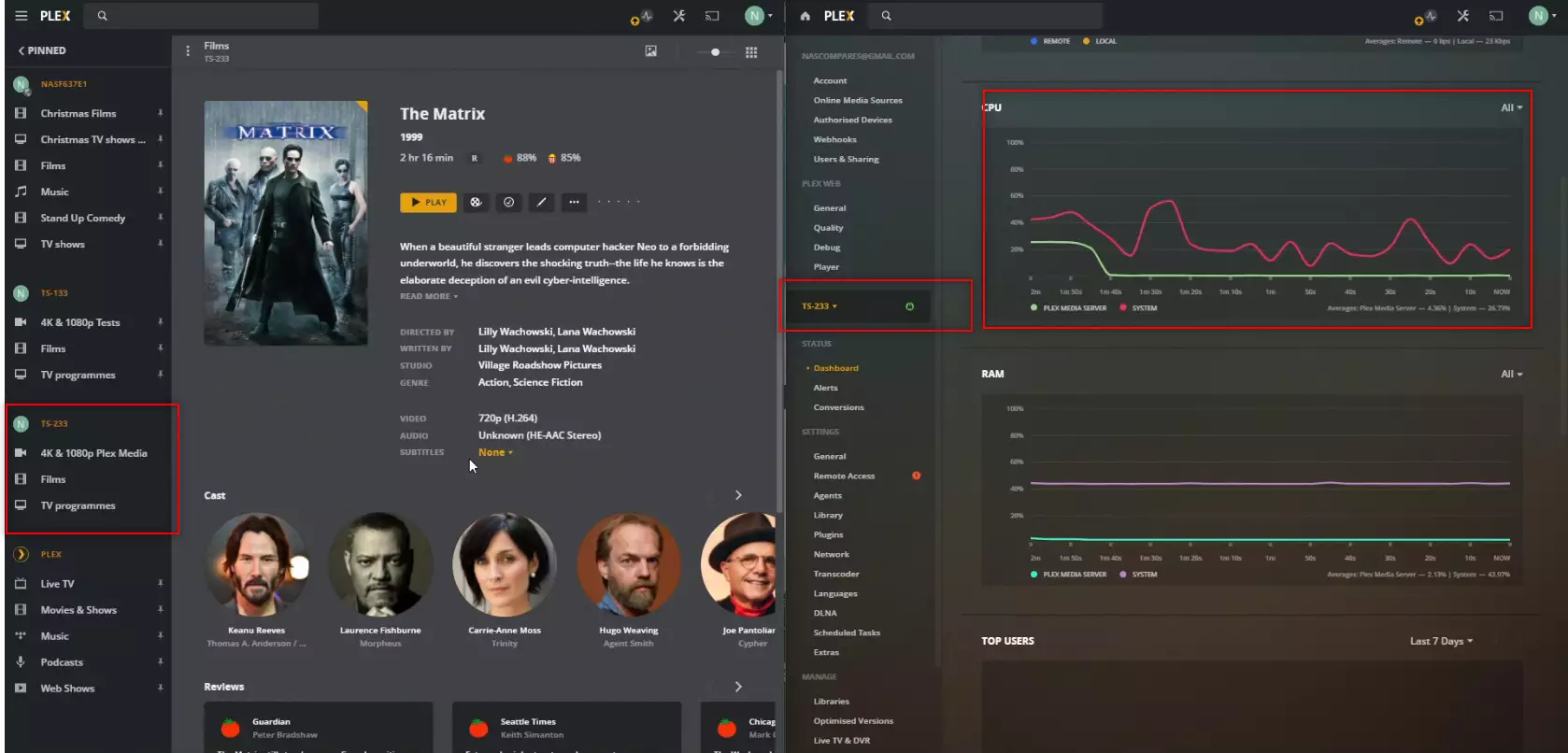
Plex Test 1 – QNAP TS-233 Plex NAS – Matrix 720p 0.7Mbps h.264 Original Playback
Here is how the QNAP TS-233 Plex NAS – Matrix 720p 0.7Mbps h.264 Original Playback File Performed:
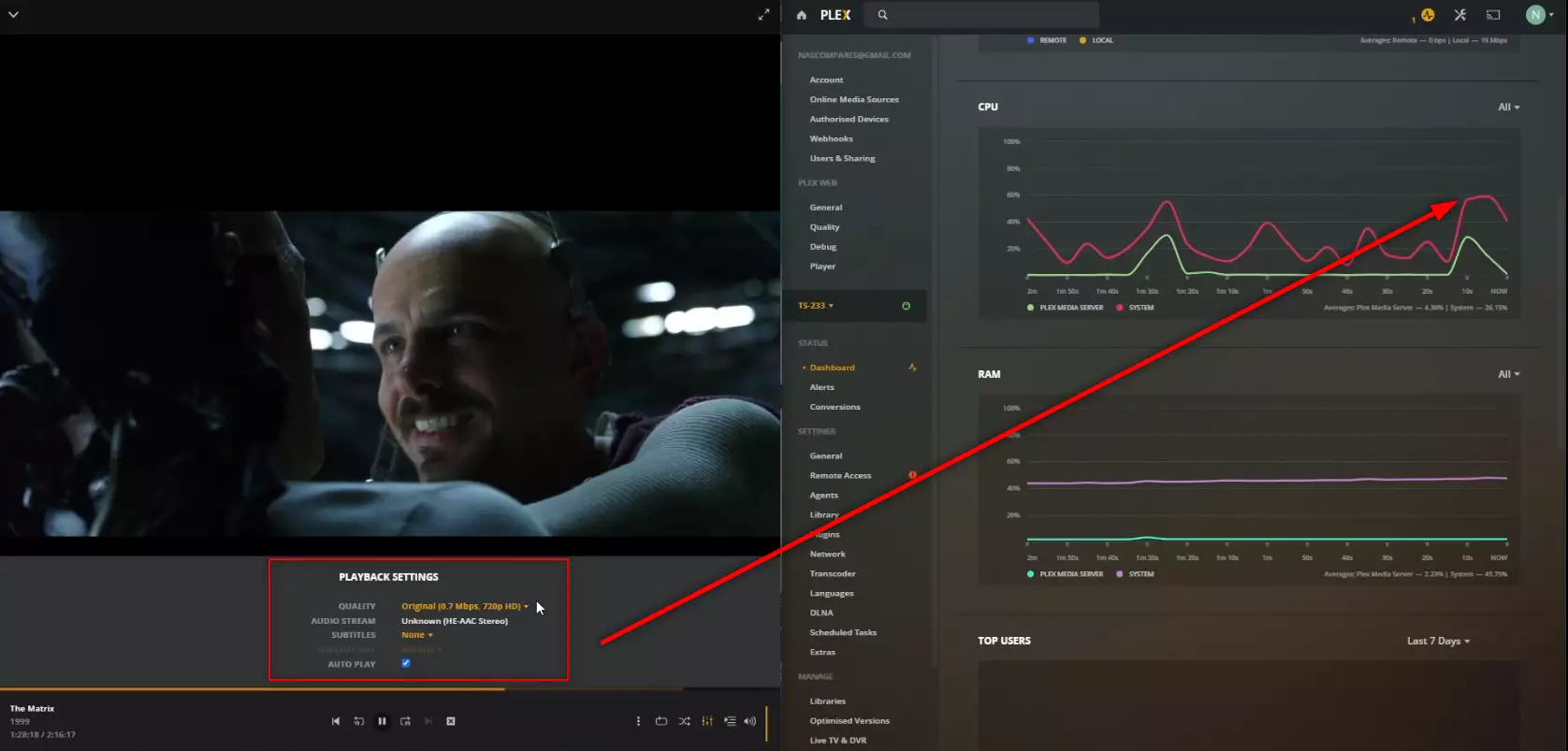
RESULT: CLEAR PASS
Extra Notes: None
Plex Test 2 – QNAP TS-233 Plex NAS – Matrix 720p 0.7Mbps h.264 Transcode to 480p 1.5Mbps
Here is how the QNAP TS-233 Plex NAS – Matrix 720p 0.7Mbps h.264 Transcode to 480p 1.5Mbps File Performed:
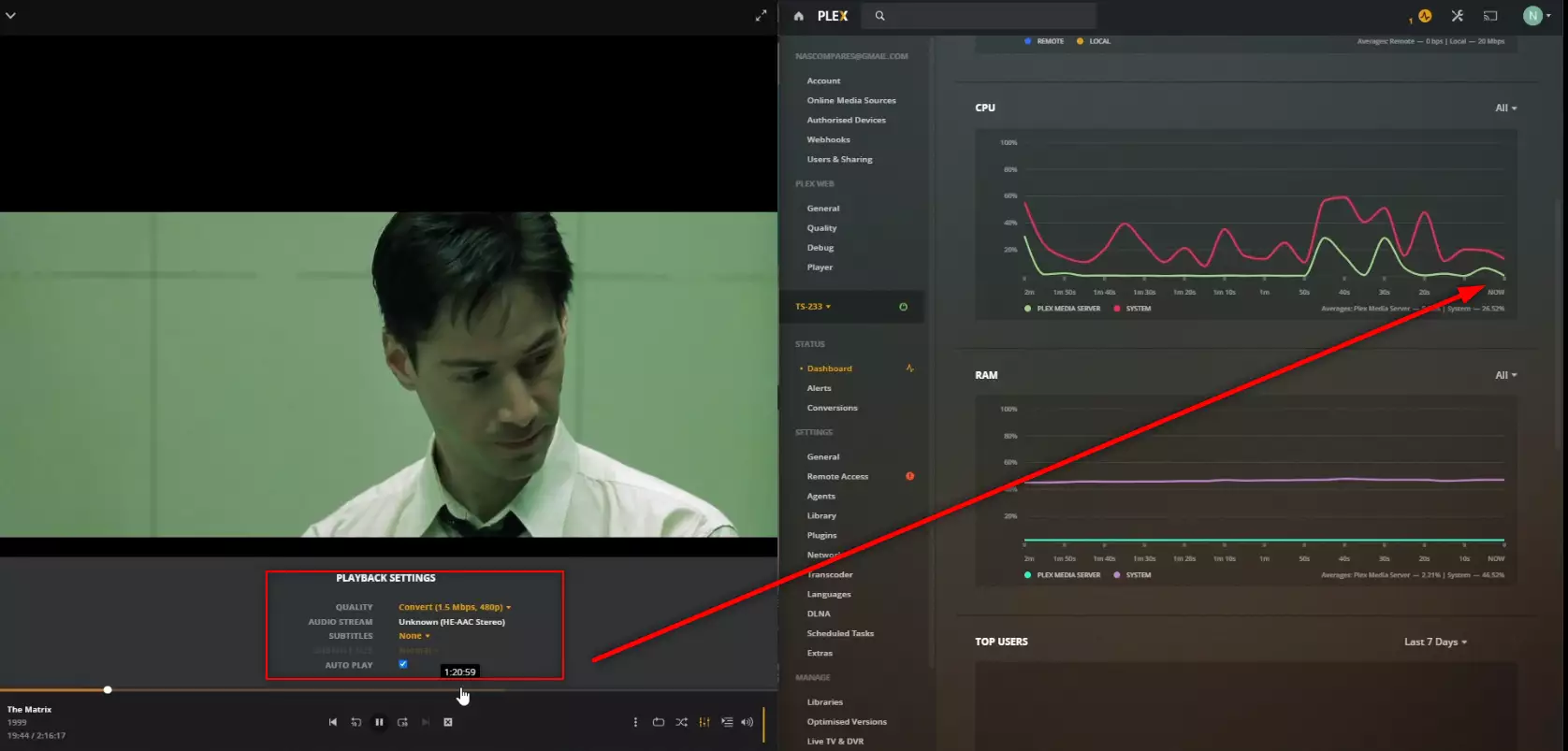
RESULT: CLEAR PASS
Extra Notes: None
Plex Test 3 – QNAP TS-233 Plex NAS – Matrix 720p 0.7Mbps h.264 Transcode to 160p 0.2Mbps
Here is how the QNAP TS-233 Plex NAS – Matrix 720p 0.7Mbps h.264 Transcode to 160p 0.2Mbps File Performed:
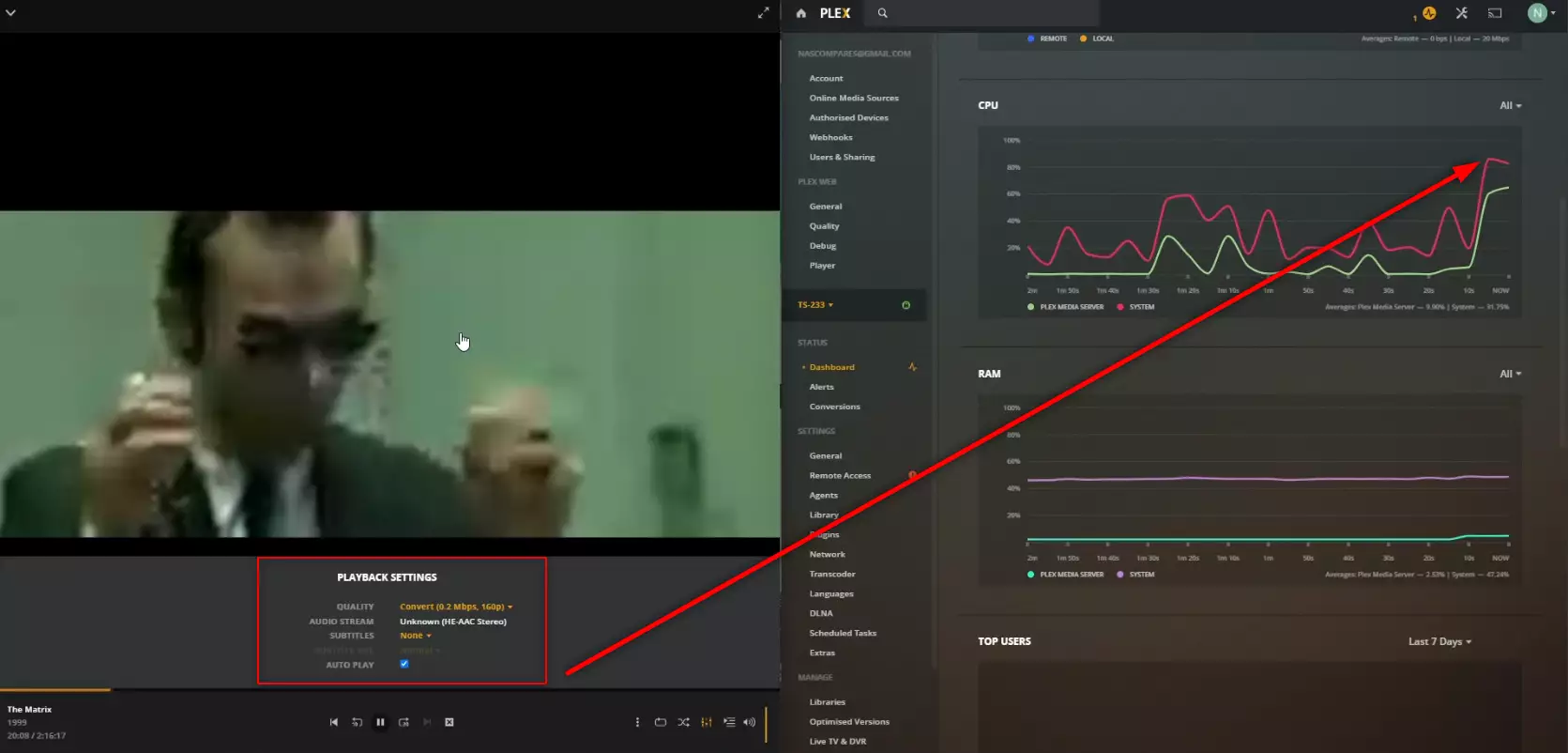
RESULT: PLAYED BUT HIGH CPU %
Extra Notes: None
Plex Test 4 – QNAP TS-233 Plex NAS – LSOH 1080p 1.9Mbps h.264 Original Playback
Here is how the QNAP TS-233 Plex NAS – LSOH 1080p 1.9Mbps h.264 Original Playback File Performed:
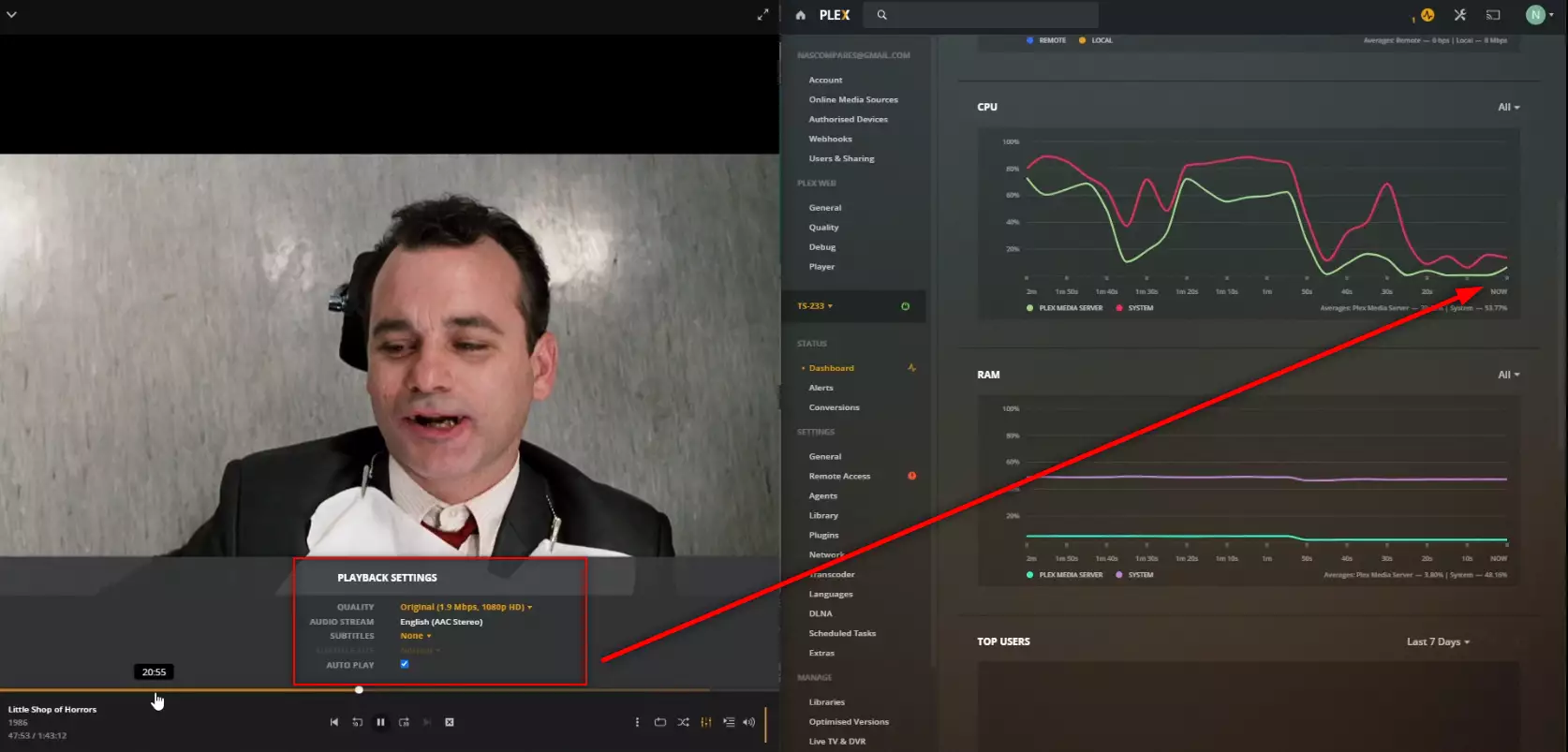
RESULT: CLEAR PASS
Extra Notes: None
Plex Test 5 – QNAP TS-233 Plex NAS – LSOH 1080p 1.9Mbps h.264 Transcode to 480p 1.5Mbps
Here is how the QNAP TS-233 Plex NAS – LSOH 1080p 1.9Mbps h.264 Transcode to 480p 1.5Mbps File Performed:
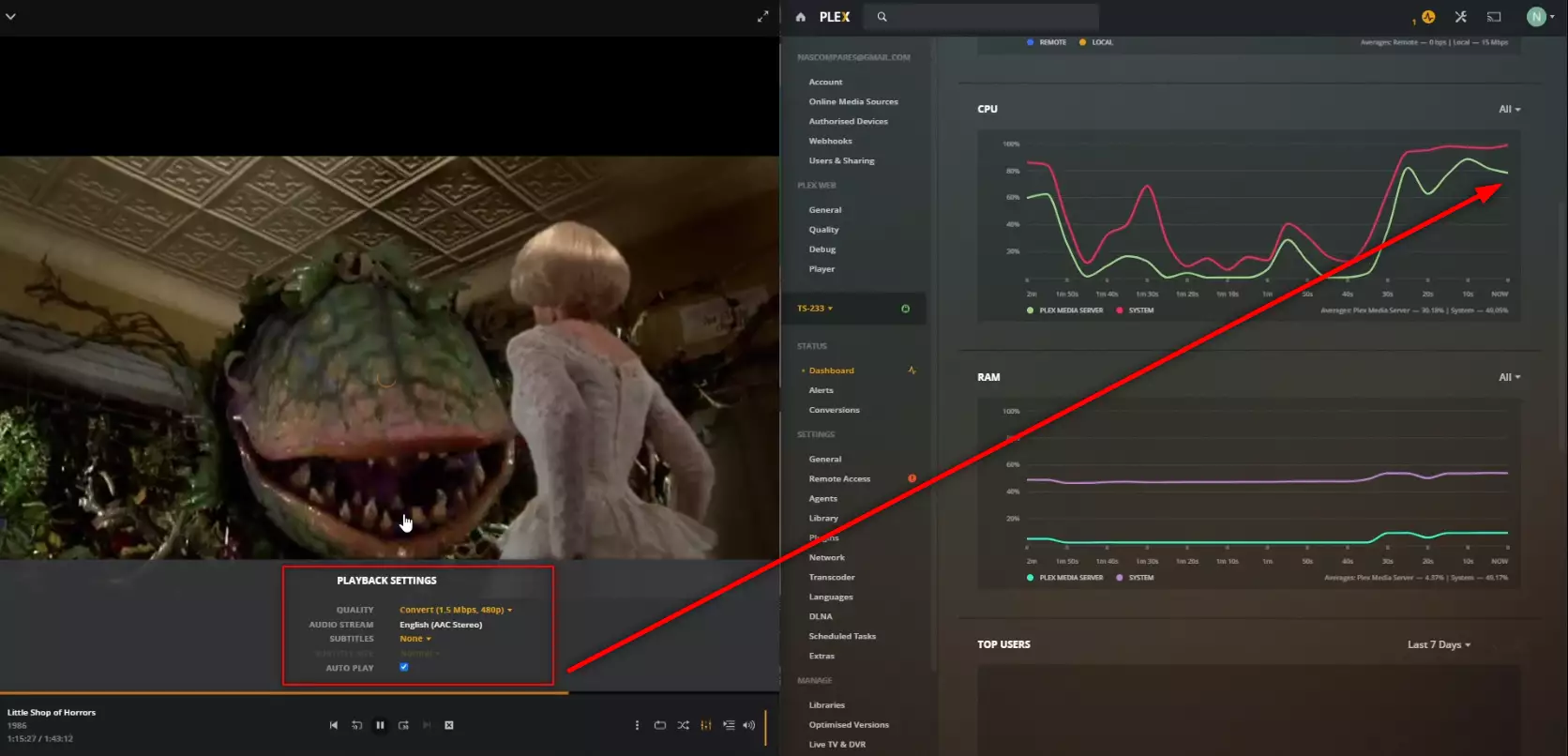
RESULT: PLAYED BUT HIGH CPU %
Extra Notes: None
Plex Test 6 – QNAP TS-233 Plex NAS – LSOH 1080p 1.9Mbps h.264 Transcode to 160p 0.2Mbps
Here is how the QNAP TS-233 Plex NAS – LSOH 1080p 1.9Mbps h.264 Transcode to 160p 0.2Mbps File Performed:

RESULT: PLAYED BUT HIGH CPU %
Extra Notes: None
Plex Test 7 – QNAP TS-233 Plex NAS – Jellyfish 1080p 3Mbps H.264 Original Playback
Here is how the QNAP TS-233 Plex NAS – Jellyfish 1080p 3Mbps H.264 Original Playback File Performed:
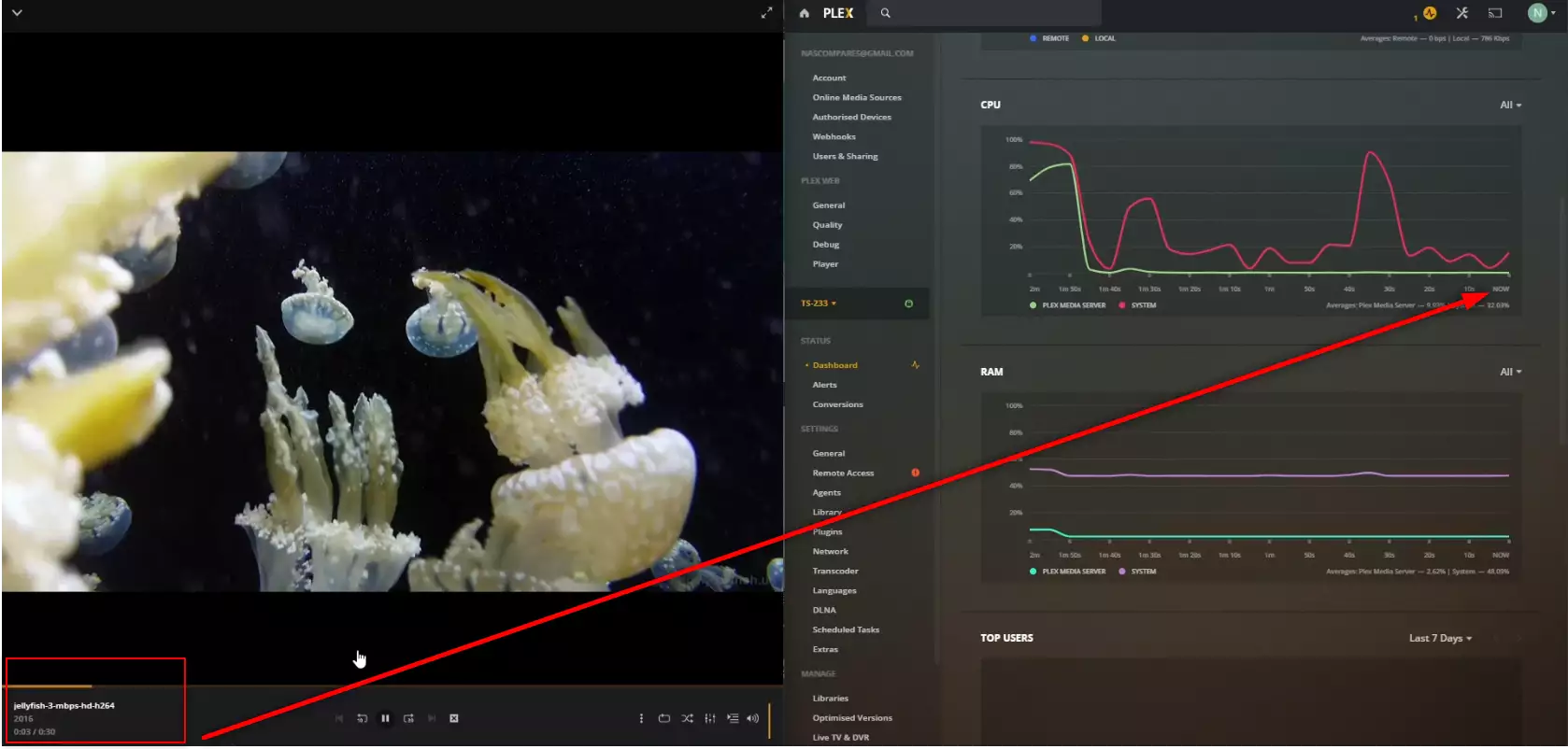
RESULT: CLEAR PASS
Extra Notes: None
Plex Test 8 – QNAP TS-233 Plex NAS – Jellyfish 1080p 10Mbps H.264 Original Playback
Here is how the QNAP TS-233 Plex NAS – Jellyfish 1080p 10Mbps H.264 Original Playback File Performed:

RESULT: CLEAR PASS
Extra Notes: None
Plex Test 9 – QNAP TS-233 Plex NAS – Jellyfish 1080p 10Mbps H.265 – HEVC CONVERTED TO H.264
Here is how the QNAP TS-233 Plex NAS – Jellyfish 1080p 10Mbps H.265 – HEVC CONVERTED TO H.264 File Performed:

RESULT: PLAYED BUT HIGH CPU %
Extra Notes: None
Plex Test 10 – QNAP TS-233 Plex NAS – Jellyfish 1080p 30Mbps H.264 Original Playback
Here is how the QNAP TS-233 Plex NAS – Jellyfish 1080p 30Mbps H.264 Original Playback File Performed:
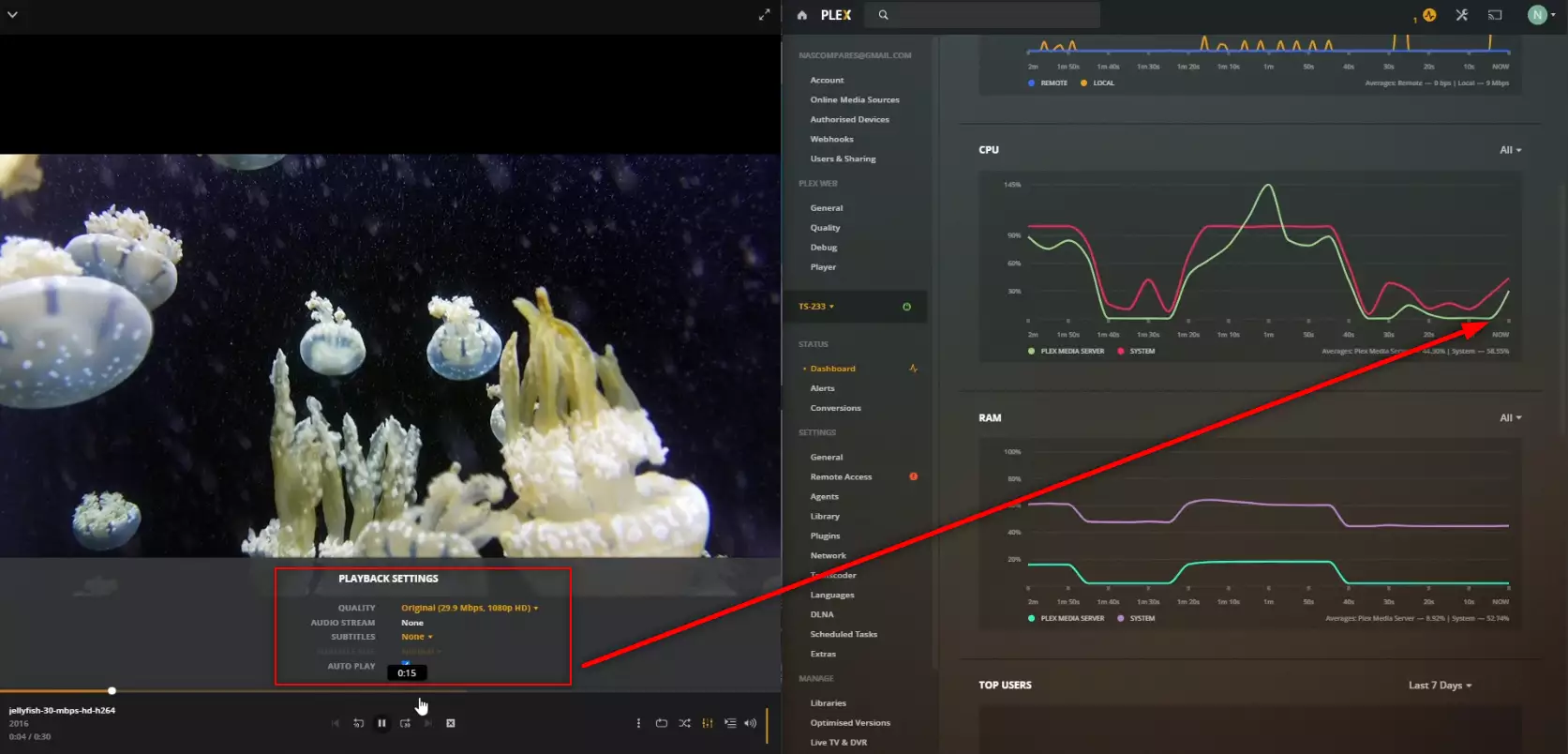
RESULT: FAIL AND-OR DID NOT PLAY
Extra Notes: None
Plex Test 11 – QNAP TS-233 Plex NAS – Jellyfish 1080p 100Mbps H.264 Original Playback
Here is how the QNAP TS-233 Plex NAS – Jellyfish 1080p 100Mbps H.264 Original Playback File Performed:

RESULT: CLEAR PASS
Extra Notes: None
Plex Test 12 – QNAP TS-233 Plex NAS – Jellyfish 4K 120Mbps H.264 Original Playback – FAILED
Here is how the QNAP TS-233 Plex NAS – Jellyfish 4K 120Mbps H.264 Original Playback – FAILED File Performed:

RESULT: FAIL AND-OR DID NOT PLAY
Extra Notes: Realistically, I had zero expectations that the TS-233 would play a 4K file in plex. So this file not playing was not a huge surprise.
Is the QNAP TS-233 NAS Any Good outside of Plex and Where Can I buy It?
If you are interested in learning more about the QNAP TS-233 NAS Drive, I am pleased to confirm that the review here on NASCompares is already live and you can find out more about this device below.
Quick Verdict of the QNAP TS-233 NAS – What We Said in the TS-233 Review:
Overall – I would say that the QNAP TS-233 NAS Drive IS good value, although maybe not as good a value as we have seen in previous releases from the brand. On the plus side, this is by far the most modern CPU that we have seen from a NAS brand in the ‘value’ tier. After a few years of fatigue from everyone using the Realtek RTD1966, this newer and more powerful/capable Cortex A55 is a breath of fresh air and allows a larger range of QNAP services and simultaneous services to be used at once. Equally, QTS 5 seems to have taken a lot of the criticism that people have had towards QNAP in 2021, its ‘default heavy’ security, over-flexibility in its design that gave some users too much rope to hang themselves and presets – then tightened many of them up, changed how users are informed of issues, bolstered the default security tools and increased its recommendations on backup tiers. QTS still has a steeper learning curve than other NAS brands, but now thing seems a lot tighter on day 1 and changing some options that users might use carelessly has been a big part of that. The 2GB of DDR4 memory in the system is a welcome day 1 inclusion too, when many affordable systems from competitors have 512GB or 1GB (which in 2022 is rather mind-boggling), however, the lack of scalability in that memory to go higher, the default 1GbE and those USB 2.0 ports are a touch surprising from a brand that generally tends to push the envelope in the hardware department more than many others. Overall, a solid release, if a little tame and safe at times. If you are looking at entering the QNAP NAS ecosystem and are on a tight budget, the TS-233 is a solid release and excellent value.
Read the Rest of the Review HERE. Alternatively, you can find out the Pros and Cons below, as a few retailers that sell the QNAP TS-233 NAS. Thanks for reading and if you need any further help choosing the right NAS for your Plex Media Server, use the free advice section linked below. Have a great week.
Where to Buy a Product





![]()
![]()

VISIT RETAILER ➤






![]()
![]()

VISIT RETAILER ➤






![]()
![]()

VISIT RETAILER ➤






![]()
![]()

VISIT RETAILER ➤
📧 SUBSCRIBE TO OUR NEWSLETTER 🔔
🔒 Join Inner Circle
Get an alert every time something gets added to this specific article!
This description contains links to Amazon. These links will take you to some of the products mentioned in today's content. As an Amazon Associate, I earn from qualifying purchases. Visit the NASCompares Deal Finder to find the best place to buy this device in your region, based on Service, Support and Reputation - Just Search for your NAS Drive in the Box Below
Need Advice on Data Storage from an Expert?
Finally, for free advice about your setup, just leave a message in the comments below here at NASCompares.com and we will get back to you. Need Help?
Where possible (and where appropriate) please provide as much information about your requirements, as then I can arrange the best answer and solution to your needs. Do not worry about your e-mail address being required, it will NOT be used in a mailing list and will NOT be used in any way other than to respond to your enquiry.
Need Help?
Where possible (and where appropriate) please provide as much information about your requirements, as then I can arrange the best answer and solution to your needs. Do not worry about your e-mail address being required, it will NOT be used in a mailing list and will NOT be used in any way other than to respond to your enquiry.

|
 |
How Much RAM Do You Need in Your NAS?
A Buyer's Guide to Travel Routers - GET IT RIGHT, FIRST TIME
Jonsbo N6 DIY NAS Case Review
The Best Bits (and Worst Bits) of NAS of 2025!
Minisforum MS-02 Ultra Review
Minisforum N5 NAS, 6 Months Later - Better, Worse, the Same?
Access content via Patreon or KO-FI
Discover more from NAS Compares
Subscribe to get the latest posts sent to your email.


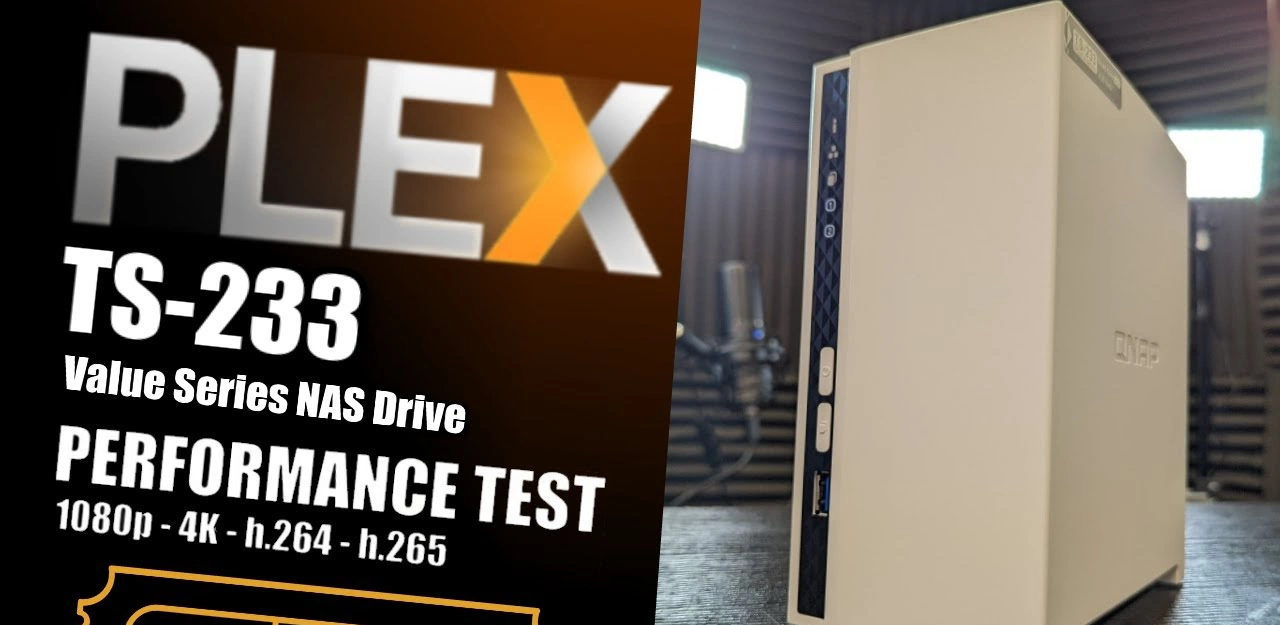



Hi! good review!. I also have a ts-233 but after installing plex, it does not run. It says “This service does not support myQNAPcloud Link”. Any ideas to help me? thanks!
REPLY ON YOUTUBE
Great video ! I wish you could have tried 4k with much lesser bit rate than 120mbps as even Netflix does 18-20mbps 4k. I don’t think majority of the people even have source with such a high 4k bit rate.
REPLY ON YOUTUBE
thank you for the review
REPLY ON YOUTUBE
As always, QNAP spit on optimization! On the Realtek RTD1296 chip in the Chinese Hikvision, hardware transcoding works natively on the built-in player. Synology Plex supports transcoding to Arm v8. It is necessary to draw the appropriate conclusions.
REPLY ON YOUTUBE
Should I purchase QNAP TS-233 or Synology Ds22+ ? Usage Backup or media files mostly movies & photos. Stream from NAS to Andorid TV
REPLY ON YOUTUBE
3-10 is a 3.3x multiplier. 30-100 is a 3.3x multiplier. Not 100 times, not thirty times… Please check your math
REPLY ON YOUTUBE
The second best NAS I have ever owned, (and I have owned Synology DS218J, QNAP TS-453A, TS 251, Terramaster F2-422, WD Mycloud). In fact it was so good that I went out and bought the 4 bay version as well .
What makes it so good?
1. RAM – 2GB is just enough to use it for Plex, download station QuMagie and Container station.
2. AI unit – Rips through images/Video on QuMagie much faster than my Intel based NAS ever could.
3. Being able to run Pi-Hole in a container. Even with the limited system resources, it can run Pi-hole well.
What makes spending the extra cash on a TS-433 the best NAS you should buy if you can run to it.
1. 4GB RAm
2. 2 Ethernet ports. (Move Pi-hole from a virtual switch to the 1Gb one)
3. 1×2/5Gbe port, for the additional speed.
4. Enough bays to add 2xSSD and utilise Qtier
in my use case I have populated the bays like this.
Bay 1. 2TB Crucial SSD for the OS and my photos stored with Qumagie.
Bay 2. 18TB Toshiba Enterprise Drive
Bays 3&4 2x500GB Seagate Ironwolf SSDs for Qtier.
USB 3. a WD 18TB drive for a weekly backup just in case Ransomware strikes.
So if you are thinking about dipping your toe into using a NAS (and you should), the TS233/TS433 are the NAS I would heartily recommend as giving the most bang per buck.
REPLY ON YOUTUBE
Interesting video. Made me check on my own NAS (ts-451d2, with 8 gb custom ram) and I have the same issues with the intel celeron J4025. Transcoding spikes my cpu up to a 100% for extended period of time. Is this normal or should i investigate/post a ticket?
REPLY ON YOUTUBE
Why even see a movie in 160p?? I can’t see why this is an issue for the CPU when this mode is not being used by anyone.
REPLY ON YOUTUBE
Really bad if we use movies that require subtitles:/
REPLY ON YOUTUBE